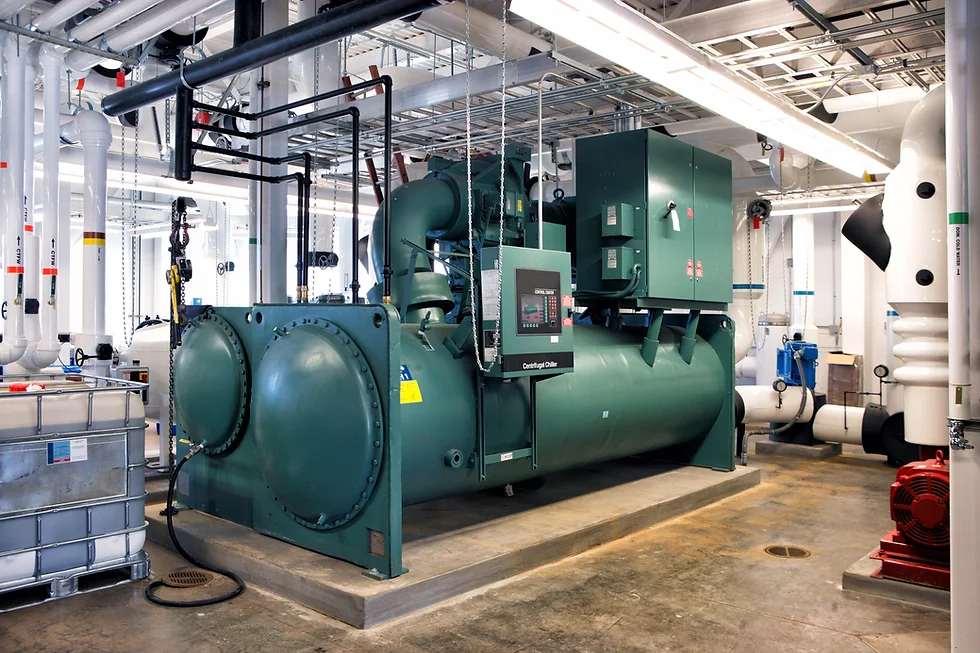Visual Inspection:
Visual inspection serves as the foundation of chiller system maintenance. By visually inspecting the equipment, technicians can detect potential issues such as leaks, vibration, noise, tightness, and cleanliness. Leaks, often indicated by water or oil traces, can be found at service valve caps, brazed fittings, and piping joints. Excessive vibration and noise can signal underlying problems and may require corrective action. Tightness of electrical and mechanical connections is essential to prevent leaks, while ensuring cleanliness promotes optimal performance and longevity.
Compressor Maintenance:
The compressor is a critical component of chiller systems, responsible for increasing the pressure of refrigerant. Routine maintenance of the compressor involves checking earthing, inspecting compressor oil quality, and conducting oil analysis. Proper earthing ensures safety and system integrity, while monitoring compressor oil quality helps identify potential issues such as impurities or degradation. Regular oil analysis provides valuable insights into the compressor’s condition, allowing for timely corrective measures. Additionally, replacing clogged oil filters is essential to prevent damage to the compressor.
Condenser Maintenance:
Condensers play a vital role in cooling the refrigerant and maintaining overall system efficiency. Air-cooled condensers require periodic cleaning to remove dust and debris that can hinder heat transfer. Fins and tubes should be inspected for damage, and any bent fins should be straightened to ensure optimal airflow. Water-cooled condensers may develop scales due to impurities in the water, necessitating descaling procedures to maintain efficiency. Chemical dosing and regular cleaning help prevent corrosion, scaling, and microbiological growth, ensuring the cooling tower operates efficiently.
Evaporator Maintenance:
The evaporator is responsible for absorbing heat from the surroundings, making its cleanliness crucial for system efficiency. Shell and tube evaporators should be cleaned periodically to remove fouling and maintain optimal performance. While condenser tubes may require annual cleaning, evaporator tubes can typically be cleaned once every three years. Proper cleaning procedures, including the use of rodding machines, ensure that evaporators operate efficiently without damaging the tubes.
Water Distribution Components Maintenance:
Water pumps, strainers, and valves are integral components of chiller systems, requiring regular maintenance to ensure smooth operation. Centrifugal pumps should be inspected for leaks, vibration, and excessive temperature, with corrective actions taken as necessary. Cleaning and lubricating strainers and valves prevent clogs and ensure proper flow control. Proper alignment of shafts and tightening of fasteners help mitigate vibration and ensure system reliability.
Seal Inspection and Replacement:
Inspecting and replacing seals, gaskets, and O-rings in chiller system components such as pumps and valves helps prevent leaks and ensure proper containment of fluids. Routine maintenance tasks include checking for signs of wear, deterioration, or damage, and replacing seals as needed to maintain system integrity and efficiency.
Electrical System Inspection:
Regular inspection of electrical components such as wiring, connections, and controls is essential for ensuring safe and reliable operation of chiller systems. Maintenance activities include checking for loose connections, damaged insulation, and signs of overheating, as well as verifying proper functioning of safety features such as overload protection and circuit breakers.
Advanced Technologies and Predictive Maintenance:
In addition to traditional maintenance practices, advancements in technology have revolutionized the way chiller systems are monitored and maintained. Predictive maintenance techniques leverage data analytics, sensors, and machine learning algorithms to anticipate potential issues before they occur, allowing for proactive interventions and minimizing downtime.
-
Condition Monitoring:
Real-time monitoring of chiller system parameters such as temperature, pressure, and vibration levels provides valuable insights into system health and performance. Advanced sensor technologies continuously collect data, which is then analyzed to detect anomalies or deviations from normal operating conditions. By identifying early warning signs of equipment degradation or malfunction, maintenance teams can take corrective action promptly, preventing costly breakdowns and optimizing system reliability.
-
Remote Monitoring and Control:
Remote monitoring and control capabilities enable maintenance personnel to access chiller system data and diagnostics remotely, allowing for timely interventions regardless of location. Cloud-based monitoring platforms provide real-time visibility into system performance, enabling proactive maintenance scheduling and optimization of energy consumption. Automated alerts and notifications notify maintenance teams of potential issues, facilitating swift response and resolution.
-
Predictive Analytics and Machine Learning:
Predictive analytics and machine learning algorithms analyze historical data and patterns to forecast equipment failures or performance degradation. By correlating various data points and identifying trends, predictive maintenance algorithms can predict the likelihood of future failures and prescribe optimal maintenance strategies. This data-driven approach minimizes downtime, reduces maintenance costs, and extends the lifespan of chiller systems.
-
Condition-Based Maintenance:
Condition-based maintenance strategies prioritize maintenance activities based on the actual condition of equipment rather than predetermined schedules. By leveraging real-time data and predictive analytics, maintenance schedules can be optimized to focus resources on components that require attention, minimizing unnecessary downtime and maximizing system availability. Condition-based maintenance enables proactive troubleshooting and targeted interventions, resulting in improved reliability and efficiency.
-
Integration with Building Management Systems (BMS):
Integration of chiller systems with building management systems (BMS) enables centralized monitoring, control, and optimization of HVAC operations. BMS platforms provide comprehensive insights into building energy usage, occupancy patterns, and environmental conditions, allowing for dynamic adjustment of chiller system parameters to optimize energy efficiency and occupant comfort. By leveraging data from multiple sources, BMS-integrated chiller systems can adapt to changing operational requirements and proactively address potential issues.
-
Vibration Analysis:
Vibration analysis is a critical tool for detecting mechanical issues in chiller system components such as compressors and pumps. By monitoring vibration levels and frequencies, maintenance technicians can identify abnormalities indicative of misalignment, bearing wear, or rotor imbalance, allowing for timely corrective action to prevent equipment failure.


